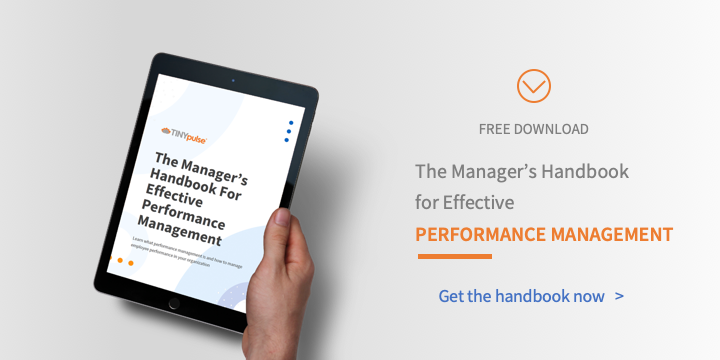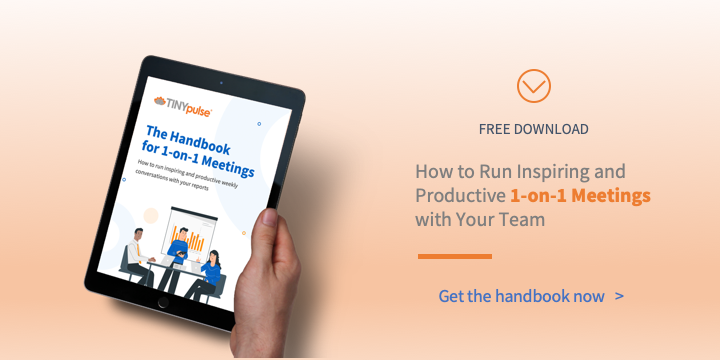How Google evolved performance management to drive top performance across its growing workforce

Performance management... What’s the first thing that comes to mind when you hear this? Is it the annual review? Performance metrics?
It might be counter-intuitive. But, truth be told, performance management isn’t just about managing performance.
What is Employee Performance Management?
Performance management is the ongoing communication between an employee and their supervisor to improve performance. Performance reviews and measures are just a small part of your organization's overall performance management system, and focusing too much on the wrong thing can backfire.
Ineffective performance management systems and processes can cause your employees to disengage. This can inadvertently have a negative impact on your organization's culture. It can also lead to decreased employee productivity and less profits for your organization.
According to a study on the effects of performance feedback interventions, the wrong type of performance feedback can actually decrease employee performance by as much as 30%!
So, how do you ensure your organization’s performance management system and processes are effective? Look no further than Google’s performance management evolution.
The Evolution of Google’s Performance Management System

When most people think about a great workplace, Google is often top of mind. From table tennis to nap pods, Google’s unique work environment has consistently helped it rank high on Fortune’s Best Companies to Work For list.
Beyond their exceptional employee perks, Google also stands out as an employer because of their world-class company culture.
But that culture wasn’t built overnight. Creating a people-first culture like Google’s takes time and dedication. For Google, their culture transformation hinged on their performance management system, which needed serious improvement.
This is when Laszlo Bock, then-Senior Vice President of People Operations at Google (their Human Resources department), came into the picture. In his book Work Rules, Bock described how Google transformed their culture by improving their performance management processes.
By relying on “people analytics,” a mix of qualitative and quantitative data, the company has been able to improve their performance management processes, employee performance, and overall employee experience.
“All it takes is a belief that people are fundamentally good—and enough courage to treat your people like owners instead of machines.” —Laszlo Bock
The insights Google’s People Operations found led to several process changes and initiatives.
Here are five key tactics you can replicate to evolve your organization’s performance management processes:
- Use midpoint employee performance check-Ins
- Include employee self-evaluations in the performance review
- Integrate 360-degree feedback in the performance appraisal
- Implement upward feedback surveys
- Hold regular one-on-one meetings
Use Midpoint Employee Performance Check-Ins

Have you ever received feedback that seemed irrelevant or that it was too little too late?
That’s one of the problems Google found with their annual performance reviews, and they aren’t alone. TINYpulse research has shown that only 41% of employees think their organization’s performance review processes are effective.
Most feedback is time-sensitive, and a lot can change in 12 months. Instead of waiting for an annual review, Google now uses a formal, midpoint check-in with their employees halfway through the annual performance review period.
By checking in before the review, employees have the opportunity to see whether they are on track to meet their performance goals. This gives them time to reflect and make adjustments before their office annual performance appraisal.
Google also ensures annual reviews and midpoint check-ins are productive and employees feel safe engaging in a conversation about their performance.
You can replicate this by focusing on outcomes—not processes. Bock suggests honing in on whether a goal was met and starting with the attitude of “How can I help you be more successful?”.
Creating a safe environment and checking in more frequently not only helps with performance improvement, it also shows respect and helps establish trust with your employees.
Include Employee Self-Evaluations in the Performance Review

When employees are self-aware, they have less blindspots and are more in tune with their weaknesses. When your employees have blindspots, it not only negatively impacts them as an individual, but it can also affect your organization’s bottom line.
Surprisingly, research has shown that 79% of employees have at least one blindspot. This research also found that poor-performing organizations had 20% more blind spots than employees at financially strong companies.
Google recognized the importance of self-awareness and now uses self-evaluations as the first step in the performance review process. The results are then compared with the employee’s 360-degree feedback (discussed below).
Being able to compare the different perspectives increases self-awareness and ultimately helps improve performance. This is why self-evaluations are a critical part of a performance management system.
By increasing self-awareness, your employees will be able to develop stronger relationships within your organization, become more productive, and improve their overall performance.
Integrate 360-Degree Feedback in the Performance Appraisal

It’s no secret that there are tremendous benefits of 360-degree feedback. This type of feedback works because it provides a well-rounded perspective.
The problem is that the process for collecting feedback is often overwhelming—for both the employee being rated and the colleague doing the rating.
In 2013, Google overcame this challenge by simplifying their annual 360-degree feedback process—and it paid off. As Bock describes in Work Rules, the percent of participants who perceived the feedback as useful rose from 49% to 75% as a result of the changes made.
Here’s how they did it:
Assessing the Overall Individual
Prior to 2013, peers at Google were asked to rate the employee by listing three to five things the employee being assessed did well and three to five things they could improve on. Now, respondents are asked to list just one thing the individual should do more of and one thing they could do differently.
This change helped make results more impactful. By focusing on just one area rather than several, the employee being assessed is able to better understand their results and set specific goals for improvement.
Assessing the Individual Employee’s Contributions
Before Google revamped their 360-feedback process, they had asked the individual being rated to list all of their accomplishments in a single field on a template. This template was then shared with employees, who were asked to rate the individual in a variety of categories.
Now that Bock’s team revised their 360-degree feedback template, employees list specific projects, their role, and their accomplishments on it. They are also limited to 512 characters per project to keep it brief.
Once the template is given to respondents, they rate the employee for each specific project instead of rating them based on all of their accomplishments. This type of feedback provides more meaningful results because employees were able to pinpoint exactly when the situation took place.
Another change Google made was ensuring the results were more relevant. They did this by asking respondents to rate how familiar they are with the project. This helps weed out random responses from individuals who aren’t aware of the employee’s actual contribution.
Collecting 360-Degree Feedback
One of the hardest parts of implementing 360-degree feedback is figuring out how to collect it. To get better data, take a cue from Google and keep it simple.
Rather than asking respondents to complete a long survey, or rate the employee in multiple, ambiguous areas, ask specific, meaningful questions. By following this approach, it will be less overwhelming for both your respondents and employees being rated.
Another strategy used by many top organizations like Google is to collect 360-degree feedback more frequently. According to Bock, Googlers are free to “solicit feedback on specific topics at any point in the year, rather than waiting for a single day.”
With performance management software like TINYpulse Coach, you can get constructive 360-degree feedback about your team anytime. The real-time data can help your employees make continuous improvements.
Sharing the 360-Feedback
Rather than relying on employees to interpret the results of their 360-degree feedback, Google now has a systematic process in place for managers to share the results with the individual who was rated.
The manager is provided with a one-page handout to use during their performance conversation with their employee. This handout includes what to cover and things for the employee to consider. The employee is also provided a copy of this hand out, just in case the manager doesn’t cover everything.
READ NOW: HOW TO GIVE CONSTRUCTIVE FEEDBACK TO YOUR COLLEAGUE
Implement “Upward Feedback” Surveys

It’s often said that employees leave managers not companies.
Google recognizes this and conducts annual upward feedback surveys where direct reports rate their managers. Within two years of starting this, the average manager score at Google rose by 5%.
“The best way to improve is by talking to those providing feedback and asking them exactly what they hope you’d do differently.” —Lazlo Bock
So why does upward feedback work?
It works because it takes the guesswork out of management. When you ask for upward feedback, you are getting information directly from your employees.
To give you a better idea of what upward feedback looks like, here are 13 questions Google asks their employees about management:
- My manager gives me actionable feedback that helps me improve my performance.
- My manager shows consideration for me as a person.
- The actions of my manager show that he/she values the perspective I bring to the team, even if it is different from his/her own.
- I would recommend my manager to other Googlers.
- My manager considers the complaints of employees.
- My manager does not micromanage (i.e., get involved in details that should be handled at other levels).
- My manager shows consideration for me as a person.
- The actions of my manager show that they value the perspective I bring to the team, even if it is different from their own.
- My manager regularly shares relevant information from their manager and senior leaders.
- My manager has the technical expertise (e.g., coding in Tech, selling in Global Business, accounting in Finance) required to effectively manage me.
- I am satisfied with my manager’s overall performance as a manager.
- My manager keeps the team focused on our priority results/deliverables.
- My manager has had a meaningful discussion with me about career development in the past six months.
At Google, managers are also encouraged to share their results and start a conversation with their employees. This helps you clarify responses and learn more about your performance as a manager.
Although TINYpulse research found that 87% of employees feel comfortable providing upward feedback, they may not have the means. Not all employees are comfortable engaging in an open, face-to-face dialogue after all.
Software like TINYpulse’s surveys can help you get the regular insights into management effectiveness that you need to improve your organization. By using a research-based survey template like the one provided in the TINYpulse app, you don’t have to overthink the questions you ask. Feedback made easy—the way it should be.
Hold Regular One-on-One Meetings

One-on-one meetings are common in organizations like Google, and for good reason. Not only do these meetings show your employees they are valued, they also help with employee development while increasing their engagement and strengthening relationships.
Google’s research found that a common trait among successful teams is psychological safety. This is formed through trust and transparency. One way to develop safety is through regular one-on-one meetings.
Google’s research also found their top-rated managers were the ones who held frequent one-on-one meetings. Google now recommends their managers hold these one-on-ones every week or two. Oftentimes, these meetings include goal-setting, identifying professional growth opportunities, and relationship-building.
If you find one-on-one meetings are a little intimidating, you are not alone. It can be challenging to come up with productive questions to ask your employees and gauge the effectiveness of these meetings.
Luckily, there are things you can do to ensure your one-on-one meeting is successful:
- Prepare
- Be present
- Collaborate
- Acknowledge
- Be consistent
If you’re stuck, a performance management solution like TINYpulse Coach can help you get started. It’s an easy way to find questions to ask, create an agenda, and track the happiness levels of your employees.
Evolve Your Organization’s Performance Management System

A quality performance management system isn’t just about annual performance reviews or performance goals. It’s the ongoing communication, frequent check-ins, and two-way feedback that creates an effective performance management system.
Discover how TINYpulse can help you revolutionize your organization’s performance management.
Share this
You May Also Like
These Related Stories

5 Best TED Talks on Performance Management
7 Ways Companies Transformed Their Annual Performance Reviews







.png?width=534&height=632&name=blog%20ad%20(1).png)
